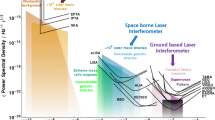Abstract
Gravitational waves in the 10–100-mHz band are inaccessible to Earth-based detectors because of seismic noise. Hitherto, the most sensitive detectors in this frequency band have been the Doppler tracking of interplanetary spacecraft1 and excitations of seismic motions in the Earth's surface2,3. Here we propose a new and more sensitive type of Earth-orbiting gravitational-wave detector, called a ‘skyhook’, which would operate in the 10–100 mHz band. The skyhook would consist of two masses, one on each end of a long thin cable with a spring at its centre. As it orbits the Earth, the cable would be stretched radially by the Earth's tidal gravitational field. Gravitational waves would pull the masses apart and push them together in an oscillatory fashion; their motion would be transmitted to the spring by the cable; and a sensor would monitor the spring's resulting motion. (An analogous skyhook, for non-gravitational-wave purposes, was proposed by Colombo4 et al. 10 years ago and is planned for flight on the space shuttle5.
Similar content being viewed by others
References
Hellings, R. W., Callahan, P. S., Anderson, J. D. & Moffet, A. T. Phys. Rev. D23, 844–851 (1981).
Dyson, F. J. Astrophys. J. 156, 529–540 (1969).
Murphy, A. J., Savino, J., Rynn, J. M. W., Choy, G. L. & McCamy, K. J. geophys. Res. 77, 5042 (1972).
Colombo, G., Gaposchkin, E. M., Grossi, M. D. & Weiffenbach, G. L. Shuttle-borne Skyhook: A New Tool for Low-Altitude Research (Smithsonian Astrophysical Observatory Reports in Geoastronomy, No. 1, 1974).
Banks, P. et al. Tethered Satellite System (Final Rep. Facility Requirements Definition Team, Utah State University Center for Atmospheric and Space Sciences, 1980).
Faller, J. E. & Bender, P. L. Natn. Bur. Stand. Spec. Publ. 617, 689–690 (1984).
Faller, J. E., Bender, P. L., Hall, J. L., Hils, D. & Vincent, M. A. in Proc. Colloq. on Telemetric Arrays in Space, Cargese (in the press).
Bisnovatyi-Kogan, G. S. Astr. Zh. (in the press).
Nulsen, P. E. J. & Fabian, A. C. Nature 312, 48–50 (1984).
Woodward, M., Thesis, Univ. California, San Diego (1984).
Frohlich, C. in Variations of the Solar Constant (ed. Sofia, S.) 37–46 (NASA Conf. Pub. 2191, Washington, DC, (1980).
Paik, H.-J. Spec. Iss. IEEE Trans. Geoscience and Remote Sensing (in the press).
Lanzerotti, L. J. & Southwood, D. J. in Solar System Plasma Physics Vol. 3 (eds Lanzerotti, L. J. Kennel, C. F. & Parker, E. N.) 109–135 (North-Holland, Amsterdam, 1979).
Mo, T. E., Maynard, N. C. & Heppner, J. P. J. geophys. Res. 85, 2099–2106 (1980).
Chu, C. K. & Gross, R. A. Amer. Inst. Aeronautics Astronautics Journal 4, 2209–2214 (1966).
Spacecraft Charging Technology (NASA Conf. Publ. 2071, Washington, D.C., 1978).
Fechtig, H., Grün, E. & Morfill, G. Planet. Space Sci. 27, 511–531 (1979).
Lanzerotti, L. J. et al. J. geophys. Res. 86, 5500–5506 (1981).
Author information
Authors and Affiliations
Rights and permissions
About this article
Cite this article
Braginsky, V., Thorne, K. Skyhook gravitational-wave detector. Nature 316, 610–612 (1985). https://doi.org/10.1038/316610a0
Received:
Accepted:
Published:
Issue Date:
DOI: https://doi.org/10.1038/316610a0
- Springer Nature Limited
This article is cited by
-
Earth-orbiting low-frequency gravitational wave detector
General Relativity and Gravitation (1996)
-
Gravitational wave background from a sample of Cataclysmic Variables
General Relativity and Gravitation (1992)
-
Astrophysics: New detectors for gravity waves
Nature (1985)





